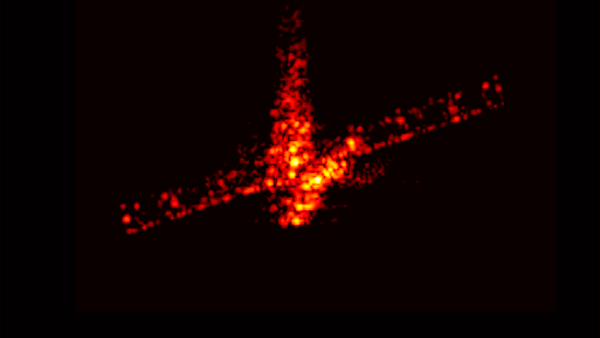See a European satellite take a fiery fall through the atmosphere in world-1st mission
ESA's wind-measuring Aeolus satellite was spotted before its flaming demise over Antarctica.

The European Space Agency has revealed final images of a trailblazing, wind-profiling spacecraft ahead of its fiery descent into the atmosphere.
On Sept. 5, the European Space Agency (ESA) released an animation constructed from the final eight images captured of its wind-measuring Aeolus spacecraft. The combined radar images show how Aeolus began to tumble as it interacted with the Earth's atmosphere at near orbital speed. "These images are our final farewell to the mission we all miss, but whose legacy lives on," Aeolus Mission Manager Tommaso Parrinello said in a statement.
Aeolus, named after the divine ruler of winds in Greek mythology, was the first ever satellite to track terrestrial winds, providing data for climate studies and meteorology. In death, it became the first spacecraft to attempt an "assisted reentry," with the satellite commanded to use its remaining fuel to progressively lower its orbit and then be passivated (or turned off).
Related: Russia's Luna-25 lander just crash-landed on the moon, space agency confirms
The images provided the last glimpses of Aeolus. The colors indicate the intensity of radar signals bounced off the spacecraft. To produce them, the Fraunhofer Institute in Germany used its 112-feet-diameter (34 meters) TIRA radar antenna to track Aeolus for about four minutes on Aug. 28, shortly after the spacecraft had received its final orders to lower its orbit and switch off its instruments.
The atmosphere then swiftly dragged it down to Earth, causing it to reenter two hours later. About 80% of the spacecraft is estimated to have burned up, with the remaining 20% of the satellite surviving its reentry over Antarctica.
The landmark reentry operation was conducted in order to test new methods of reducing the low-but-existent risk of debris making its way to Earth. "During Aeolus's first-of-its-kind assisted reentry in July, not only was the (already low) risk from falling debris reduced by a factor of 150, but the time during which Aeolus was left uncontrolled in orbit was shortened by a few weeks, limiting the risk of collision with other satellites in this vital space highway." according to the ESA statement.
Sign up for the Live Science daily newsletter now
Get the world’s most fascinating discoveries delivered straight to your inbox.
The procedures tested with Aeolus's reentry will help inform the end-of-life plans for future missions.
"With Aeolus, in a remarkable example of sustainable spaceflight and responsible operations, we stayed with the mission for as long as we could, guiding its return as much as it was possible to do," Parrinello said.

Andrew is a freelance space journalist with a focus on reporting on China's rapidly growing space sector. He began writing for Live Science sister site Space.com in 2019, and he also writes for SpaceNews, IEEE Spectrum, National Geographic, Sky & Telescope, New Scientist and others. Andrew first caught the space bug when, as a youngster, he saw Voyager images of other worlds in our solar system for the first time. Away from space, Andrew enjoys trail running in the forests of Finland.










